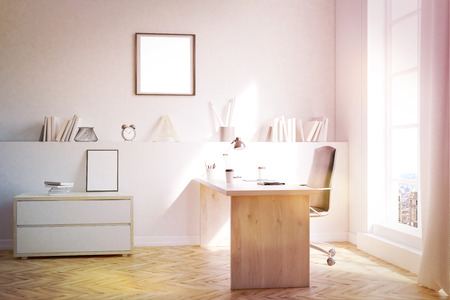Introduction to Feng Shui in the British Home Office
In today’s dynamic UK work culture, more professionals are embracing home offices, making the optimisation of these spaces both an art and a necessity. The ancient practice of Feng Shui, rooted in harmonising energy flow within living environments, is increasingly finding relevance among British homeowners seeking balance between productivity and personal wellbeing. As remote work becomes a permanent fixture in British lifestyles, the demand for energy-aware, thoughtfully designed workspaces continues to rise. Unlike traditional office setups, the British home office now blends personal comfort with professional functionality—a unique context where Feng Shui’s principles can truly shine. By integrating concepts such as spatial clarity, natural light maximisation, and purposeful placement of furnishings, UK residents are discovering how Feng Shui not only enhances aesthetic appeal but also supports mental clarity and motivation. This renewed interest reflects a broader cultural shift towards mindful living, where creating positive energy flow is seen as integral to both efficiency and holistic health in the modern British home office.
2. Identifying Common Energy Flow Challenges in British Homes
When transforming the energy flow of a British home office with Feng Shui, it is essential to recognise the unique spatial constraints and cultural nuances found within UK properties. Unlike modern open-plan apartments, many British homes—particularly Victorian terraces and period cottages—feature compact rooms, distinctive architectural details, and limited access to natural light. These factors present both challenges and opportunities for enhancing chi (energy) within a workspace.
Typical Spatial Constraints in UK Home Offices
| Feature | Description | Impact on Energy Flow |
|---|---|---|
| Victorian Terrace Layouts | Narrow, elongated rooms with high ceilings and fireplaces as focal points. | Can create stagnant or funnelled energy; may require creative furniture placement to encourage movement. |
| Period Features | Original cornices, bay windows, alcoves, and ornate skirting boards. | Offer character but may obstruct optimal desk positioning or restrict wall space for shelving. |
| Limited Natural Light | Small windows or north-facing aspects are common in historic buildings. | May result in lower vitality and productivity; solutions often involve mirrors or strategic lighting. |
| Multi-Functional Spaces | Home offices frequently double as guest rooms or storage areas. | Dilutes purpose-driven energy and can lead to clutter accumulation if not managed sensitively. |
Cultural Nuances Impacting Home Office Design
British homeowners place significant value on heritage features and maintaining the integrity of their property’s period style. This often leads to a reluctance to make bold structural changes, favouring subtle adjustments that honour tradition. Furthermore, the British affinity for privacy shapes room layouts—with doors typically kept closed during work hours—affecting air circulation and energetic openness. Finally, a pragmatic approach to space usage means every inch must serve multiple functions without sacrificing comfort or aesthetics. Understanding these cultural factors is vital when applying Feng Shui principles in a way that feels authentic and sustainable within a UK context.

3. Case Study One: London Townhouse Renewal
Redefining Space in a Classic Setting
Set within the heart of Chelsea, this quintessential London townhouse presented both charm and challenge. The home office, tucked away on the first floor, originally suffered from stagnant energy and lacked visual clarity—a common issue in period properties with narrow corridors and ornate layouts. Our brief was to revitalise this workspace, blending modern productivity needs with traditional British character through the artful application of Feng Shui principles.
Initial Assessment: Identifying Energy Blockages
The office’s original configuration placed the desk facing a blank wall, with its back to the door—a layout that inadvertently hindered focus and invited distraction. Tall bookcases dominated one side, casting shadows and constricting movement. The room felt heavy, its energy flow dulled by clutter and poor lighting—obstacles to both creative thinking and efficient work.
Subtle Adjustments for Profound Change
By repositioning the desk to face the doorway, we established a commanding position, promoting confidence and awareness—crucial for decision-making. We introduced soft task lighting and replaced heavy curtains with lighter, natural fabrics to invite more daylight, echoing the British appreciation for precious sunlight. Clutter was addressed with bespoke cabinetry, blending seamlessly with Edwardian cornices while providing discreet storage.
Personal Touches Rooted in Local Culture
In keeping with British sensibilities, personal artefacts—such as vintage cricket prints and a classic leather-bound notebook—were carefully curated as part of the décor. A small potted English ivy brought life to a corner, symbolising growth and resilience.
The Outcome: Elevated Energy & Productivity
The transformation resulted in an invigorated energy flow that encouraged productivity without compromising the historic integrity of the space. Subtle Feng Shui adjustments fostered an environment where inspiration could thrive—a testament to how traditional wisdom can harmoniously coexist with contemporary British home office culture.
4. Case Study Two: Countryside Cottage Workspace
For many across the British countryside, the allure of working from a charming period cottage is undeniable. However, rural properties bring their own set of challenges when it comes to creating a home office that supports both productivity and well-being through Feng Shui principles. This case study explores how one homeowner in the Cotswolds transformed a dim, draughty box room into an energised workspace, while preserving the cottage’s historic character.
Challenges Unique to Rural Cottages
| Challenge | Description | Feng Shui Implication |
|---|---|---|
| Low Ceilings & Small Windows | Typical in older cottages, reducing natural light and airflow. | Can restrict Chi flow and create a sense of heaviness or lethargy. |
| Irregular Room Shapes | Crooked walls and awkward angles due to period architecture. | Disrupts energy movement, leading to stagnant pockets. |
| Draughts & Dampness | Poor insulation often results in cold spots and moisture issues. | Negative energy accumulation, impacting focus and comfort. |
Bespoke Feng Shui Remedies Applied
- Zoning with Soft Partitions: A lightweight oak bookcase was strategically placed to subtly define the workspace from the rest of the multi-purpose room, allowing energy to circulate without blockages.
- Maximising Natural Light: Heavy curtains were replaced with linen Roman blinds in soft sage green—a nod to British country style—inviting sunlight and uplifting Chi into the space.
- Clever Use of Mirrors: An antique gilt mirror was positioned opposite the window, amplifying available daylight and visually expanding the compact room, while also reflecting positive energy.
- Damp Management: Himalayan salt lamps and a small dehumidifier helped purify the air and neutralise musty odours, supporting clearer mental energy during work hours.
- Nostalgic Touches for Comfort: Vintage botanical prints, a tartan wool throw, and a vase of fresh wildflowers brought warmth and emotional grounding—a subtle way to attract nurturing Earth element energy.
Results: Enhanced Energy Flow & Well-Being
The transformation achieved not only a brighter and more inviting work environment but also tangible improvements in focus and motivation. The combination of tailored Feng Shui adjustments with classic British décor ensured that the workspace felt harmonious with its rural setting while meeting modern needs. Feedback from the homeowner highlighted reduced fatigue, improved air quality, and an increased sense of connection to both nature and heritage.
5. Design Details: British Materials, Colours, and Accents
In the transformation of British home offices through Feng Shui, every detail matters—from the texture beneath your feet to the hue that dances across your walls. Integrating locally sourced materials not only supports sustainability but also grounds the workspace in a sense of place and heritage. For example, oak desks crafted from British wood provide both stability (a key Feng Shui principle) and a nod to traditional craftsmanship. Heritage colours, such as deep Oxford blue, soothing sage green, or warm Farrow & Ball neutrals, evoke classic British interiors while supporting the balance of yin and yang energies. Fixtures like brass lamp fittings or porcelain doorknobs introduce a layer of period charm; these accents are chosen not just for their aesthetic value but for their ability to enhance energy flow—brass symbolising clarity and communication, porcelain offering a gentle reflective quality. Layering natural textiles such as Scottish wool throws or linen curtains ensures tactile comfort and acoustic softness, both crucial for focus and relaxation in a home office. Ultimately, honouring British design traditions with mindful selection of materials, colours, and accents creates a harmonious environment where cultural identity and positive chi coexist beautifully.
6. Measurable Outcomes and Resident Feedback
Once British homeowners embraced Feng Shui principles within their home offices, the positive impacts became evident not only in the flow of the space but also in their daily lives. Residents consistently reported a renewed sense of wellbeing, highlighting an improved ability to manage work-related stress and maintain emotional balance throughout busy weeks. Many attributed this to the harmonious arrangement of furniture, strategic use of natural light, and subtle incorporation of elements such as plants and calming artwork.
Focus was another measurable outcome that stood out across case studies. Homeowners noticed marked improvements in their concentration levels, citing fewer distractions and increased productivity during working hours. This was particularly significant for those who previously struggled with motivation or found themselves easily sidetracked by household activities. The clarity brought about by uncluttered layouts and mindful organisation allowed for a more purposeful approach to tasks.
Perhaps most impressive were the sustainable habits that emerged following these Feng Shui transformations. Residents shared stories of adopting regular decluttering routines, integrating breaks with mindfulness practices, and even re-evaluating their energy consumption for both environmental and personal benefit. These lifestyle adjustments not only supported ongoing success within the home office but also contributed to a healthier home environment overall.
Feedback from participants revealed a deep appreciation for how these changes aligned with British values of comfort, practicality, and understated elegance. Many felt a renewed pride in their workspaces—spaces that now reflected both personal style and a thoughtful approach to energy flow. The combination of tangible wellbeing benefits, enhanced focus, and sustainable living practices underscores why Feng Shui continues to gain popularity among UK homeowners seeking meaningful transformations.
7. Guidance for Integrating Feng Shui into Your UK Home Office
Embracing British Heritage in Feng Shui Practices
Creating an energised and harmonious home office in the UK isn’t about dramatic overhauls—it’s about weaving Feng Shui principles seamlessly into the unique character of British homes. Whether you’re working from a Victorian terrace in London or a cosy cottage in the Lake District, respecting your property’s architectural heritage while optimising energy flow is key.
Actionable Steps for Harmonious Energy Flow
1. Honour Natural Light and Views
British weather can be unpredictable, so position your desk near windows to maximise natural light on brighter days. Use sheer curtains to soften harsh light without blocking it completely—this balances energy and lifts mood, particularly during longer winter months.
2. Choose Furniture with Intention
Select furniture that complements your home’s period features. Opt for solid wood desks and chairs with curved edges—these echo traditional British craftsmanship while supporting smooth chi (energy) circulation. Avoid cluttering with excessive filing cabinets; keep storage discreet and organised.
3. Incorporate Calming Colours and Textiles
Draw inspiration from classic British palettes: sage green, duck egg blue, or warm neutrals like stone and oatmeal. Layer with wool throws or tartan cushions to add texture, comfort, and a nod to local tradition, all while enhancing a sense of calm focus.
4. Bring the Outdoors In
Plants such as English ivy or lavender pots not only purify the air but also connect your workspace with nature—a core tenet of both British garden culture and Feng Shui. Place plants at east- or southeast-facing windows for optimal growth and energy renewal.
5. Curate Personal Touches Mindfully
Display framed family photos, beloved books, or vintage accessories that tell your story. Arrange these items thoughtfully—avoid overcrowding shelves or desktops to prevent stagnant energy.
Cultural Sensitivity: Blending Old and New
When integrating Feng Shui into your UK home office, balance modern productivity needs with the charm of British interiors. Celebrate original fireplaces, bay windows, or exposed beams by making them focal points rather than hiding them behind screens or storage.
Sustaining Balance for Long-Term Success
Finally, make regular decluttering a habit—a simple weekly tidy-up keeps energy flowing and maintains clarity of thought. By embracing these culturally attuned strategies, you’ll foster both harmony and efficiency in your personal workspace, ensuring it supports both well-being and productivity in true British style.


